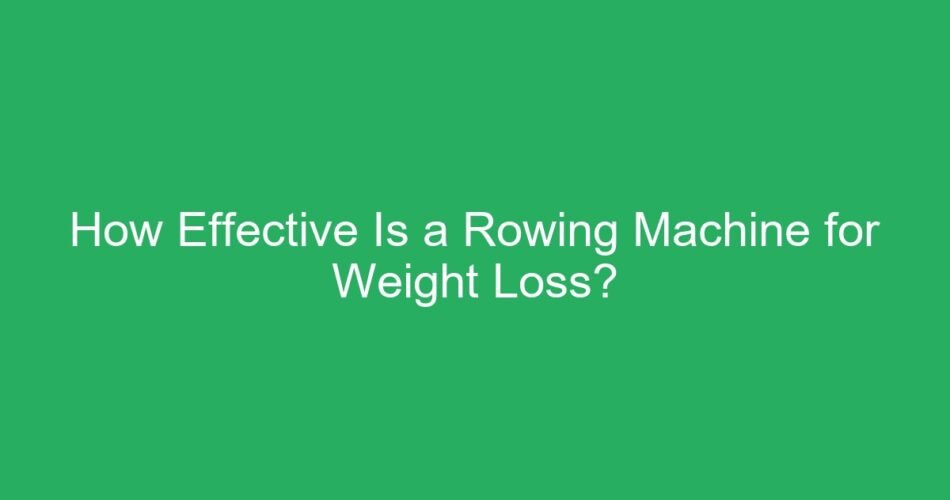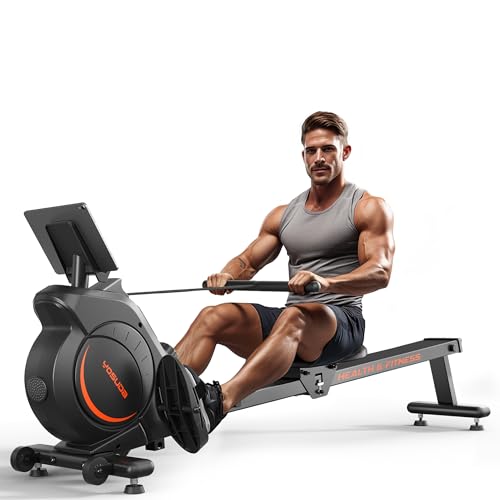Rowing machines are arguably one of the most effective tools for weight management and body composition change. Discover precisely how effective a rowing machine for weight loss and why experts recommend this full-body cardio exercise.
How Effective Is a Rowing Machine for Weight Loss? Rowing machines are extremely effective for weight loss, offering an intense, low-impact, total-body workout that maximizes calorie expenditure and boosts metabolism. Due to its unique combination of strength and cardio training, the rower burns more calories than many other common fitness machines, making it a powerful tool for achieving a sustainable calorie deficit. To maximize fat loss and weight management, rowing should be incorporated regularly alongside a consistent diet.
Calorie Burn and Metabolic Impact
Weight loss fundamentally relies on creating a calorie deficit, meaning you burn more calories than you consume. Rowing is highly efficient at achieving this deficit quickly. Because the rowing stroke engages nearly every major muscle group simultaneously, the body requires a huge amount of energy to sustain the movement, leading to substantial calorie burn.
🛒 Recommended Product
According to data compiled by Harvard Health Publishing, a person weighing 185 pounds can burn approximately 377 calories in just 30 minutes of vigorous rowing. This translates to over 750 calories per hour, placing rowing among the highest calorie-burning activities available, often surpassing traditional cardio like cycling or running at a moderate pace.
The effectiveness of rowing for weight loss extends beyond the session itself due to its metabolic impact. Intense rowing workouts stimulate EPOC (Excess Post-exercise Oxygen Consumption), commonly known as the afterburn effect. This phenomenon keeps the metabolism elevated for hours after the workout is completed, meaning you continue to burn additional calories even while at rest.
The Full-Body Advantage
Unlike treadmills or stationary bikes which primarily target the lower body, the rowing machine provides a legitimate full-body workout, which is central to determining how effective a rowing machine for weight loss is. Engaging more muscle mass requires greater energy expenditure, driving up the calorie burn.
During a proper rowing stroke, approximately 86% of the body’s musculature is involved, demanding coordination and power from both the upper and lower halves. The movement is broken down into four phases:
- The Catch: Requires core engagement and shoulder stability.
- The Drive: This is the powerful phase, utilizing the glutes, hamstrings, and quadriceps (60% of the power comes from the legs).
- The Finish: Engages the upper back, shoulders, triceps, and biceps as the handle is pulled toward the chest.
- The Recovery: Requires controlled movement from the core to return to the starting position.
By building muscle mass across the back, legs, and core while simultaneously engaging in intense cardiovascular activity, the rower helps improve overall body composition. Increased lean muscle tissue raises the basal metabolic rate (BMR), making it easier to maintain weight loss long-term.
Optimizing Weight Loss: HIIT and Steady State
To maximize calorie expenditure and body fat reduction, athletes utilize two primary training methods on the rowing machine: High-Intensity Interval Training (HIIT) and Steady-State Cardio. Both methods leverage the rowing motion for maximum weight management benefits.
🛒 Recommended Product
High-Intensity Interval Training (HIIT)
HIIT involves short bursts of maximum effort followed by periods of low-intensity recovery. This method is highly efficient for individuals short on time. A standard HIIT session might involve 30 seconds of all-out rowing followed by 60 seconds of light recovery rowing, repeated for 20 minutes. HIIT is superior for triggering EPOC and improving cardiovascular fitness rapidly.
Steady-State Cardio
Steady-state rowing involves maintaining a consistent, moderate pace for a longer duration, typically 30 to 60 minutes. This method is excellent for developing endurance and is often preferred for sessions designed to burn a higher percentage of calories directly from fat stores. While less intense than HIIT, consistent steady-state cardio is essential for achieving the necessary volume of exercise required for significant weight loss.
Rowing’s Superior Calorie Density
When comparing rowing to other popular cardio equipment, the rower often holds a distinct advantage in terms of calorie density—the number of calories burned per unit of time, per level of joint impact.
The low-impact nature of rowing is a key factor in its effectiveness. Because the feet remain strapped to the footrests and the movement is fluid, rowing minimizes stress on the joints, particularly the knees and ankles. This allows individuals, including those with previous injuries or excess weight, to perform longer and more intense workouts without the risk of overuse injuries common in high-impact activities like running. This sustainability ensures consistency, which is crucial for achieving weight loss goals.
| Activity (30 Minutes, 185 lbs Person) | Calories Burned (Approximate) | Primary Impact Level | Muscles Engaged |
|---|---|---|---|
| Vigorous Rowing | 377 | Low | Total Body (86%) |
| Stationary Cycling (Vigorous) | 311 | Low | Lower Body |
| Running (10 min/mile) | 355 | High | Lower Body |
| Elliptical Trainer (General) | 324 | Low | Lower Body, Arms (less engagement) |
| Water Aerobics | 185 | Very Low | Total Body (low intensity) |
Note: Calorie estimates are based on general fitness data, such as that provided by established medical institutions, and can vary based on individual intensity and physiology.
🛒 Recommended Product
In conclusion, the rowing machine is one of the most powerful tools available for comprehensive weight loss and body conditioning. By combining maximal calorie burn, metabolic stimulation, and low impact, the rowing machine offers a sustainable path to achieving a calorie deficit necessary for effective weight management.
Scientific References & Research
The following peer-reviewed research papers provide additional scientific context:
-
A Temraz (2022).
The effectiveness of using a rowing machine for developing aerobic capacity and technical skills in rowing
[External Link] -
H De las Casas et al. (2019).
Eccentric training with a powered rowing machine
[External Link] -
B Sanderson et al. (1986).
[PDF] Towards optimizing rowing technique
[External Link]
Note: External research links are provided for educational purposes and do not necessarily represent endorsement.
Frequently Asked Questions About How Effective Is a Rowing Machine for Weight Loss?
Q. Is it necessary to combine diet changes with regular rowing to see significant weight loss results?
A. Absolutely; weight loss fundamentally relies on creating a sustainable calorie deficit, which rowing helps achieve through significant calorie burn. However, without adjusting dietary habits to consume fewer calories than expended, even intense rowing sessions will yield limited results. Combining a consistent rowing routine with a nutrient-rich, calorie-controlled diet is the most effective strategy for sustainable, long-term weight management.
Q. How often and for how long should a beginner row to start seeing noticeable weight loss within the first month?
A. A beginner should aim for 3–4 sessions per week, with each session lasting 20–30 minutes at a moderate-to-high intensity level. Consistency is key, and focusing on proper form will prevent injury and maximize muscle engagement, ensuring efficient calorie burning. As fitness improves, gradually increasing duration or intensity will maintain the metabolic challenge necessary for continued weight loss progress.
Q. Does the intensity level (e.g., steady state vs. HIIT) on the rowing machine significantly impact its effectiveness for fat burning?
A. Yes, both steady-state and High-Intensity Interval Training (HIIT) are effective but target fat burning differently. HIIT sessions maximize post-exercise oxygen consumption (EPOC), leading to a higher ‘afterburn’ effect where the body continues to burn calories long after the workout finishes. Steady-state rowing is excellent for building foundational endurance and burning a large volume of calories during the session itself, making a combination of both the most effective strategy.
Q. Can rowing alone help reduce visceral fat, which is often linked to serious health risks?
A. Yes, rowing is highly effective in reducing visceral fat because it is a strenuous, whole-body aerobic exercise that elevates the heart rate significantly. Consistent high-intensity cardio, such as rowing, forces the body to tap into fat stores, including metabolically active visceral fat, for energy. Regular rowing improves overall cardiovascular health and directly contributes to a reduction in harmful belly fat.
Q. What role does building muscle mass through rowing play in the overall weight loss process?
A. Building muscle mass through rowing is crucial because muscle tissue is metabolically much more active than fat tissue. Increased lean muscle mass elevates the resting metabolic rate (RMR), meaning the body burns more calories even when at rest. Therefore, while rowing burns calories during the workout, the added muscle mass ensures a higher daily caloric burn, making long-term weight maintenance easier.
Q. Are there specific common mistakes people make on the rowing machine that can undermine its effectiveness for weight loss?
A. The most common mistake is neglecting proper form, often by over-relying on the arms and upper body rather than utilizing the powerful leg drive (the ‘catch’). Incorrect form reduces muscle engagement, lowers the intensity of the workout, and significantly decreases the overall calorie burn, making the session less effective for weight loss. Another error is rowing at too low a resistance or intensity, failing to reach the necessary heart rate zone for optimal fat burning.
Related Articles
What Is the Best Workout Machine for Weight Loss?
Trying to determine what is the best workout machine for weight loss? While several options deliver results, the rowing machine often provides the max…
Do Vibrating Weight Loss Machines Work?
Do vibrating weight loss machines work? The scientific data is clear: while these vibration therapy plates offer proven benefits like muscle stimulati…
Treadmill Workouts for Buttocks: Sculpt and Tone Your Glutes
Getting fit and shaping your buttocks can be challenging. Treadmill workouts might be the solution you need. Treadmill workouts are not just for cardi…
When you purchase a product through Amazon links on EllipticalKing.com, we may earn a small commission at no extra cost to you. This helps support the site and keep our content free.




